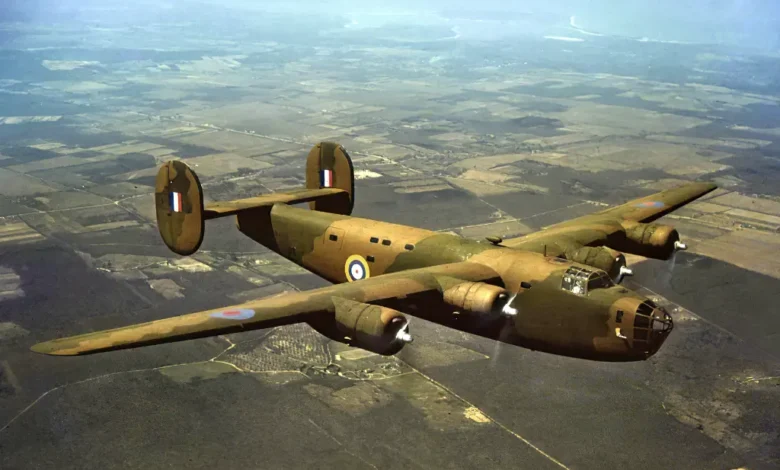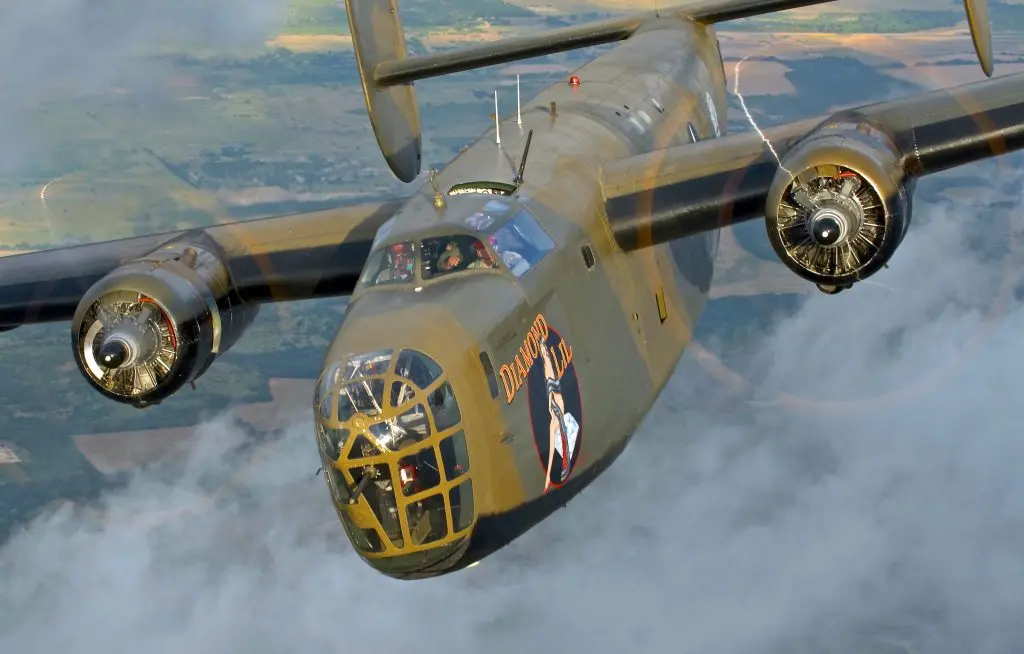Consolidated B-24 Liberator

The Consolidated B-24 Liberator was a highly versatile American heavy bomber used extensively during World War II. Known for its long range, high payload capacity, and innovative design, the B-24 became one of the most produced bombers in history, with over 18,400 units built. It played a critical role in strategic bombing campaigns, anti-submarine warfare, and cargo transport.
Fact Sheet
| Role | Heavy Bomber |
|---|---|
| Manufacturer | Consolidated Aircraft |
| First Flight | December 29, 1939 |
| Service Entry | 1941 |
| Crew | 10 |
| Number Built | 18,482 |
Specifications (B-24J Model)
| Length | 67 ft 8 in (20.6 m) |
|---|---|
| Wingspan | 110 ft (33.5 m) |
| Height | 18 ft (5.5 m) |
| Wing Area | 1,048 sq ft (97.36 m²) |
| Empty Weight | 36,500 lb (16,556 kg) |
| Loaded Weight | 55,000 lb (24,948 kg) |
| Max Takeoff Weight | ~65,000 lb (29,484 kg) |
| Powerplant | 4 × Pratt & Whitney R-1830-65 Twin Wasp radial engines (1,200 hp each) |
| Max Speed | 290 mph (467 km/h) |
| Cruise Speed | 215 mph (346 km/h) |
| Range | 2,100 mi (3,380 km) with 5,000 lb bomb load |
| Service Ceiling | 28,000 ft (8,535 m) |
| Rate of Climb | 1,025 ft/min (5.2 m/s) |
Armament & Defensive Equipment
| Guns | Up to 13 × .50 in (12.7 mm) M2 Browning machine guns (various positions) |
|---|---|
| Bomb Load | Up to 8,000 lb (3,600 kg) typical, maximum up to 12,800 lb (5,800 kg) for short-range missions |
| Aiming Equipment | Norden bombsight for precision targeting |
Notable Features
- High payload capacity and long range for strategic bombing missions
- Distinctive “Davis wing” design for improved lift and efficiency
- Versatile roles including anti-submarine warfare and cargo transport
- Extensive use in both European and Pacific theaters during WWII
- One of the most produced bombers in history

The Consolidated B-24 Liberator was one of the most iconic and widely produced heavy bombers of World War II. Known for its distinctive high aspect ratio “Davis wing,” twin tail, and large bomb bay, the Liberator played a crucial role in Allied strategic bombing campaigns across all major theaters of war.
B-24 Development and Production: A Symbol of Industrial Might
Development of the B-24 began in January 1939 when the United States Army Air Corps (USAAC) sought a heavy bomber with longer range and a higher cruising altitude than the Boeing B-17 Flying Fortress. Consolidated Aircraft’s design, spearheaded by chief engineer Isaac M. Laddon, focused on maximizing efficiency and bomb-carrying capacity. The prototype, designated XB-24, made its maiden flight on December 29, 1939.
The B-24 quickly became a symbol of American industrial might during World War II. With over 18,000 units produced (some sources cite up to 19,256 including all variants), it holds the distinction of being the most mass-produced American military aircraft in history. Production was distributed across multiple plants, including Consolidated’s facilities in San Diego and Fort Worth, and critically, the massive Ford Willow Run bomber plant in Michigan, which pioneered assembly line techniques for aircraft production. Other manufacturers like Douglas (Tulsa) and North American (Dallas) also contributed to the immense production effort.
B-24 Design Features: Range, Payload, and Defensive Armament
The B-24’s design incorporated several distinctive features:
- Davis Wing: A unique high-aspect-ratio wing designed by David R. Davis, which was longer and narrower than conventional designs. This highly efficient wing provided excellent lift and reduced drag, contributing to the Liberator’s impressive range and bomb-carrying capacity. However, it also made the aircraft less forgiving to fly at high altitudes and in formation.
- Twin Tail: The B-24 featured a distinctive twin vertical stabilizer tail assembly.
- Deep Fuselage: The “slab-sided” fuselage, often criticized for its appearance, was deep and allowed for a spacious, internal bomb bay with retracting “clamshell” doors that rolled up into the fuselage, reducing drag. This innovative design enabled the B-24 to carry a substantial bomb load of up to 8,000 lbs (3,629 kg), and in some later variants, up to 12,800 lbs (5,806 kg) over shorter distances.
- Four Pratt & Whitney R-1830 Twin Wasp Engines: These radial engines, each producing 1,200 hp, provided the power for the Liberator’s long-range missions.
- Heavy Defensive Armament: Early models had limited defensive armament, but later and most common variants (like the B-24J) were heavily armed with up to 10-12 or more .50 caliber (12.7 mm) M2 Browning machine guns in powered turrets (nose, dorsal, ball, and tail) and waist positions, providing significant protection against enemy fighters.
B-24 Variants: Specialization and Evolution
The B-24 family evolved into numerous variants, each addressing specific operational needs:
- B-24D: The first major production variant, featuring an all-glass nose for the bombardier and a ventral “ball” turret.
- B-24E/G/H: Variants incorporating various improvements, often related to manufacturing or minor changes in turrets. The B-24H introduced an improved powered nose turret.
- B-24J: The most widely produced variant (over 6,600 built), standardizing features like the Emerson nose turret and an improved autopilot and bombsight.
- B-24L/M: Lighter versions with modified tail gun positions to reduce weight.
- C-87 Liberator Express: An unarmed transport variant with a lengthened nose, windows, and cargo doors, used for carrying passengers and high-value cargo over long distances. Winston Churchill famously used a modified C-87A as his personal transport.
- C-109: An unarmed fuel transport (tanker) variant.
- F-7: Photographic reconnaissance versions equipped with multiple cameras.
- PB4Y-1 Liberator: The U.S. Navy’s designation for B-24s, often modified for maritime patrol and anti-submarine warfare (ASW), sometimes with search radar in place of the belly turret.
- PB4Y-2 Privateer: A significantly redesigned naval variant, easily identifiable by its single, tall vertical tail fin (replacing the twin tails), elongated fuselage, and additional defensive armament (often including ERCO nose turrets and blistered waist gun positions). The Privateer was purpose-built for maritime patrol and was the last Liberator variant to see active service in the U.S. military.
- RY-3 (Liberator C.Mk.IX): A transport version of the PB4Y-2 Privateer, primarily used by the Royal Air Force.
B-24 Combat History: Global Deployment
The B-24 Liberator saw extensive service in every major theater of World War II, serving with the United States Army Air Forces (USAAF), United States Navy (USN), Royal Air Force (RAF), and other Allied air forces (including the Royal Australian Air Force, Royal Canadian Air Force, South African Air Force, and others).
- European Theater of Operations (ETO): Liberators were instrumental in the strategic daylight bombing campaign against Nazi Germany, targeting industrial complexes, military installations, and transportation networks from bases in England, North Africa, and Italy. They operated alongside B-17s, often flying deep into enemy territory. One of the most famous and costly B-24 missions was Operation Tidal Wave in August 1943, a low-level attack on the oil refineries at Ploiești, Romania.
- Pacific Theater: The B-24’s long range was particularly crucial in the vast distances of the Pacific, allowing it to strike Japanese forces from remote island bases where no closer land-based airfields were available. They conducted bombing raids on Japanese strongholds, anti-shipping strikes, and served as long-range reconnaissance aircraft.
- Battle of the Atlantic: B-24s, particularly the RAF’s Coastal Command variants and later the USN’s PB4Y-1s, played a critical role in closing the “Mid-Atlantic Gap,” an area beyond the reach of land-based anti-submarine aircraft. Their long endurance allowed them to patrol extensively, hunting and sinking German U-boats, contributing significantly to the Allied victory in the Battle of the Atlantic.
- Cargo and Special Operations: The transport variants (C-87, C-109) were vital for ferrying personnel and supplies, while some B-24s were specially modified for “Carpetbagger” missions in Europe, dropping supplies and agents to resistance movements.
Despite some crew complaints about its handling characteristics (it was considered more demanding to fly in tight formation than the B-17), the B-24 was rugged and versatile, proving its worth in a wide array of missions.
B-24 Legacy and Retirement
Following World War II, the B-24 Liberator was rapidly phased out of front-line service by most major powers. Thousands were scrapped, deemed surplus to requirements with the advent of newer, faster bombers like the B-29 Superfortress. However, some variants, particularly the PB4Y-2 Privateer, continued to serve with the U.S. Navy for several years.
Remarkably, the Indian Air Force (IAF) became the last operator of the B-24. They acquired a significant number of ex-RAF Liberators left behind in India after the war. These aircraft were extensively refurbished by Hindustan Aircraft Limited (HAL) and remained in IAF service until their final retirement in 1968, making India the last nation to operate the Liberator.
Today, very few B-24 Liberators survive. Of the over 18,000 built, only 13 complete airframes are known to exist, with typically one or two remaining airworthy and regularly flying for airshows and commemorative events, such as the Collings Foundation’s “Witchcraft” (though its flying status is currently affected by a tragic 2019 accident involving a B-17). The B-24 Liberator remains a powerful symbol of Allied air power and the immense industrial effort of World War II.



